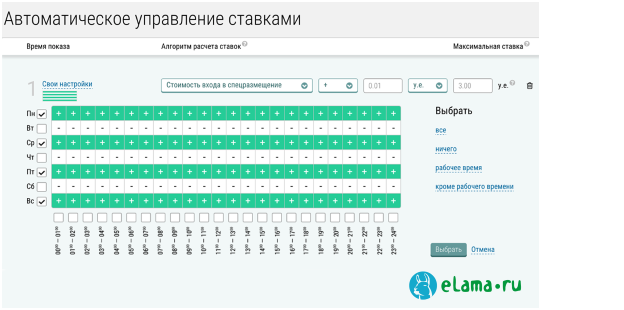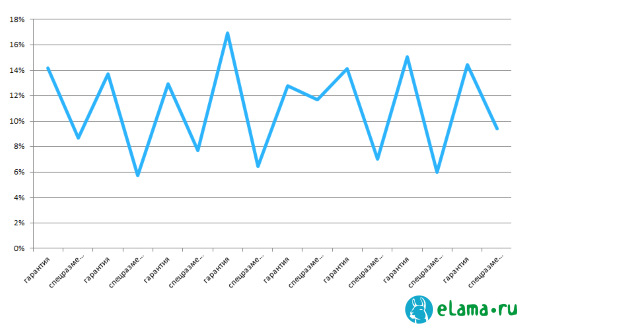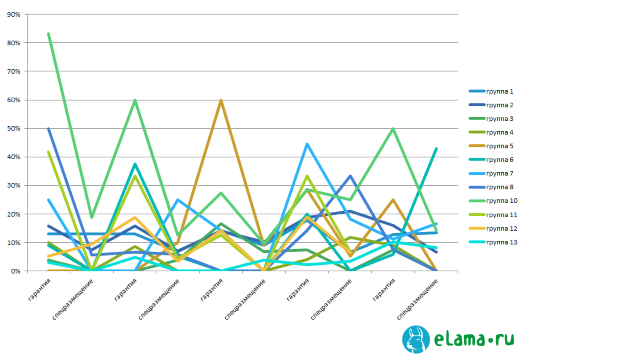How to save up to 44% of the budget on the context, if your site is in the top of Yandex
If the site is at the same time in top positions in organic delivery and special placement in contextual advertising, which of the two links will the user navigate to? Which channel will bring traffic to the advertiser?
Most users will follow the top link - the contextual ad. The advertiser will pay for these clicks, although if the ad was disabled, he could receive free referrals from the search. It turns out that one channel pulls users from another. This phenomenon is called traffic cannibalization.
It turns out, contextual advertising takes away the clicks of those users who would have already gone to the site via a link from the organic issue. Let's find out to what extent this happens, and how it affects advertising costs.
')
The first to study the cannibalization of traffic was taken up by Google experts, then Yandex research appeared. According to Google, if you turn off contextual advertising, you can lose about 85% of traffic. This value is called IAC - Incremental Ad Clicks.
In other words, about 15% of the traffic that provides context to advertisers and so brings organic.
According to a Yandex study, if a website ranks first in search results, when contextual advertising is turned off, advertisers cannot compensate up to 48% of traffic.

Fig. 1. Yandex research results: IAC values depending on the position of the site in the organic issue
It turns out that contextual advertising takes organic matter from 10 to 50% of traffic. To obtain more accurate data, we decided to conduct our own research at eLama.ru.
We set 2 tasks: to calculate exactly what proportion of traffic is delaying the context, and whether it really happens all the time.
Let us consider in more detail the conditions of the experiment, so that if you wish, you can conduct it for your project.
The survey involved advertisers from various industries: tire sales, installation of plastic windows, and children's clothing.
Among the requests, we chose those that provide these sites with impressions on the first five lines at least three hundred times a month on a Yandex search. We took only commercial requests, informational and branded did not use. Also, one of the conditions was the placement for a certain key request, 3 contextual announcements in the special placement and 4 - in the guarantee.
Then we started testing. We created two absolutely identical advertising campaigns and launched them alternately. In one day, the first campaign worked in special placement. The next time we turned it off and started the second one in the block of guaranteed hits. So we managed to get a representative sample.

Fig. 2. Setting up an advertising campaign for research
So we were able to track the CTR in the search results. When a user enters a query into a search engine, contextual advertising is displayed either in the upper or in the lower block. Having built in Yandex.Direct a report on the number of ad impressions for the phrase of interest, we get the number of queries to the search engine. The number of clicks on this query from the search results can be viewed in Yandex.Metrica. Dividing one by the other, we get the CTR for this phrase in the organic issue.
As a result, we found out that as soon as the context is launched in special placement, the number of clicks on links from the search results decreases by an average of 44%.
On average, for all groups of requests, the CTR in SEO with the context in the special placement was 8.1%, and with the context only under the search results - 14.55%.

Fig. 3. The dependence of clicks on the links in the organic issue of the placement of contextual advertising
Of course, the CTR could not be the same in all cases. Differences may be associated, for example, with the characteristics of a particular ad, or with the position of the site in the search results.
This graph shows the dependence of transitions to the site from the search results when contextual advertising is shown in special placement and guarantees. It can be traced that when placing ads in the guarantee, the number of transitions from the search increases, and when showing advertising in special placement - is reduced.

Fig. 4. Fluctuations of traffic from search depending on the placement of contextual advertising
Despite the fact that the data on ad groups are different, the general trend is clearly visible: the context does indeed always take away traffic from organics.
Now we will understand how the delay in traffic affects the advertising budget.
The cost of the order can be calculated as the ratio of costs to conversions. When contextual advertising is enabled, the flow of customers from the search is reduced by about 44%. For calculations, round the value to 40%.
That is, if the site is in the top five search results, when you run contextual advertising on the issue, you can get only about 60% of new customers:
CPO Context in Special Placement = CPC * clicks / (conversion * 0.6)
If your task is to get as many conversions at any cost, it is beneficial for you to launch contextual advertising in special placements. But if you need to optimize the budget, you can reduce the cost per click by 44%.
Thus, if a site for a particular search query is included in the top five search results, to optimize the budget, the maximum rate in the context should be multiplied by a reduction factor of 20 - 40%. To calculate the coefficient, you can also rely on data from a Yandex study on IAC (see Fig. 1).
Managing rates manually and so difficult, and if at the same time every time we also take into account the coefficients, the task becomes almost impossible.
But here comes to the aid of advertisers automation. After the research, we in eLama.ru supplemented our bid automation tool with the ability to take into account the position in Yandex search as well.
The maximum bid will be recalculated depending on the time of day and the position of the site in the search results for certain queries.

Fig. 5. Automatic bid management depending on the position in the search in eLama.ru
When working with this tool, we advise you to consider the following factors. To make it work as precisely as possible, include it only for campaigns with as precise semantics as possible or for campaigns with exact match requests.
It is also necessary to tune geo-targeting as accurately as possible, since search results may differ in different regions.
Remember that multiple searchable ads may appear on a single search query. But it is not always possible to check which positions the site occupies in the search for all these key queries.
And the last. Since search engines take into account search histories of specific users, conduct experiments, etc., the same site can occupy different positions on different devices of different users.
Summing up, we can advise you the following: attract users through both channels, but remember that one channel can pull traffic from another, and take this into account when pricing.
Most users will follow the top link - the contextual ad. The advertiser will pay for these clicks, although if the ad was disabled, he could receive free referrals from the search. It turns out that one channel pulls users from another. This phenomenon is called traffic cannibalization.
It turns out, contextual advertising takes away the clicks of those users who would have already gone to the site via a link from the organic issue. Let's find out to what extent this happens, and how it affects advertising costs.
')
How much context does a search take away?
The first to study the cannibalization of traffic was taken up by Google experts, then Yandex research appeared. According to Google, if you turn off contextual advertising, you can lose about 85% of traffic. This value is called IAC - Incremental Ad Clicks.
In other words, about 15% of the traffic that provides context to advertisers and so brings organic.
According to a Yandex study, if a website ranks first in search results, when contextual advertising is turned off, advertisers cannot compensate up to 48% of traffic.

Fig. 1. Yandex research results: IAC values depending on the position of the site in the organic issue
It turns out that contextual advertising takes organic matter from 10 to 50% of traffic. To obtain more accurate data, we decided to conduct our own research at eLama.ru.
eLama is doing research
We set 2 tasks: to calculate exactly what proportion of traffic is delaying the context, and whether it really happens all the time.
Let us consider in more detail the conditions of the experiment, so that if you wish, you can conduct it for your project.
The survey involved advertisers from various industries: tire sales, installation of plastic windows, and children's clothing.
Among the requests, we chose those that provide these sites with impressions on the first five lines at least three hundred times a month on a Yandex search. We took only commercial requests, informational and branded did not use. Also, one of the conditions was the placement for a certain key request, 3 contextual announcements in the special placement and 4 - in the guarantee.
Then we started testing. We created two absolutely identical advertising campaigns and launched them alternately. In one day, the first campaign worked in special placement. The next time we turned it off and started the second one in the block of guaranteed hits. So we managed to get a representative sample.

Fig. 2. Setting up an advertising campaign for research
So we were able to track the CTR in the search results. When a user enters a query into a search engine, contextual advertising is displayed either in the upper or in the lower block. Having built in Yandex.Direct a report on the number of ad impressions for the phrase of interest, we get the number of queries to the search engine. The number of clicks on this query from the search results can be viewed in Yandex.Metrica. Dividing one by the other, we get the CTR for this phrase in the organic issue.
What we got
As a result, we found out that as soon as the context is launched in special placement, the number of clicks on links from the search results decreases by an average of 44%.
On average, for all groups of requests, the CTR in SEO with the context in the special placement was 8.1%, and with the context only under the search results - 14.55%.

Fig. 3. The dependence of clicks on the links in the organic issue of the placement of contextual advertising
Of course, the CTR could not be the same in all cases. Differences may be associated, for example, with the characteristics of a particular ad, or with the position of the site in the search results.
This graph shows the dependence of transitions to the site from the search results when contextual advertising is shown in special placement and guarantees. It can be traced that when placing ads in the guarantee, the number of transitions from the search increases, and when showing advertising in special placement - is reduced.

Fig. 4. Fluctuations of traffic from search depending on the placement of contextual advertising
Despite the fact that the data on ad groups are different, the general trend is clearly visible: the context does indeed always take away traffic from organics.
Counting money
Now we will understand how the delay in traffic affects the advertising budget.
The cost of the order can be calculated as the ratio of costs to conversions. When contextual advertising is enabled, the flow of customers from the search is reduced by about 44%. For calculations, round the value to 40%.
That is, if the site is in the top five search results, when you run contextual advertising on the issue, you can get only about 60% of new customers:
CPO Context in Special Placement = CPC * clicks / (conversion * 0.6)
If your task is to get as many conversions at any cost, it is beneficial for you to launch contextual advertising in special placements. But if you need to optimize the budget, you can reduce the cost per click by 44%.
Thus, if a site for a particular search query is included in the top five search results, to optimize the budget, the maximum rate in the context should be multiplied by a reduction factor of 20 - 40%. To calculate the coefficient, you can also rely on data from a Yandex study on IAC (see Fig. 1).
How to optimize rates in context, taking into account the positions of the site in the search
Managing rates manually and so difficult, and if at the same time every time we also take into account the coefficients, the task becomes almost impossible.
But here comes to the aid of advertisers automation. After the research, we in eLama.ru supplemented our bid automation tool with the ability to take into account the position in Yandex search as well.
The maximum bid will be recalculated depending on the time of day and the position of the site in the search results for certain queries.

Fig. 5. Automatic bid management depending on the position in the search in eLama.ru
What is important to pay attention to when managing bids depending on positions in the search
When working with this tool, we advise you to consider the following factors. To make it work as precisely as possible, include it only for campaigns with as precise semantics as possible or for campaigns with exact match requests.
It is also necessary to tune geo-targeting as accurately as possible, since search results may differ in different regions.
Remember that multiple searchable ads may appear on a single search query. But it is not always possible to check which positions the site occupies in the search for all these key queries.
And the last. Since search engines take into account search histories of specific users, conduct experiments, etc., the same site can occupy different positions on different devices of different users.
Summing up, we can advise you the following: attract users through both channels, but remember that one channel can pull traffic from another, and take this into account when pricing.
Presentation of the study at the conference "SPIK 2015"
Source: https://habr.com/ru/post/295902/
All Articles